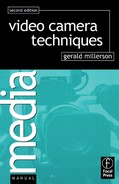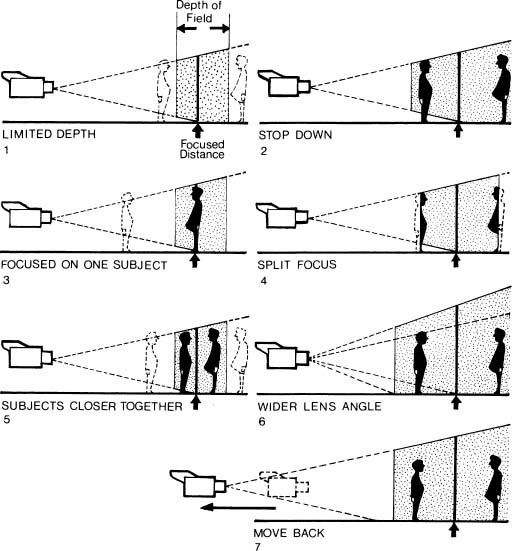Except for the odd occasion where you deliberately defocus for effect (e.g. to suggest dizziness), you normally try to keep your main subject focused as sharply as possible. Anyone can tell whether a printed page is in focus, but you will meet situations where focusing is much less exact. When shooting faces, use the eyes (sometimes the teeth or hair) to judge. If necessary, rock the focus control to and fro to get the sharpest image. In longer shots, use costume detail for focus checks. Take care that you don’t inadvertently focus on prominent background detail, while your less defined main subject remains ‘soft’! It happens!
In most situations, we adjust the lens aperture to correct the exposure: stopping down in bright light; opening up under dim conditions. We accept whatever depth of field results. But there are times when you want to select the f-stop to present the subject in a particular way:
• Deep-focus techniques – Here the aim is to show everything in the scene from close foreground to the furthest distance, sharply focused. That may be ideal when shooting widespread action, or where several subjects are at different distances from the camera. But continual overall clarity can lead to pictures that look flat, and lack atmosphere, unless the lighting is dramatic, with strong perspective.
For maximum depth, the lens must be stopped down – and that will necessitate considerable light levels. An alternative is to focus the lens at the hyperfocal distance.
• Shallow-focus techniques – To isolate close subjects against a blurred background, use a large lens aperture to restrict focused depth. In this way you can separate a foreground speaker from distracting or confusing background action, or prevent a flower from merging with its leafy surroundings. To avoid over-exposure, use a neutral density (ND) filter.
When you have insufficient depth of field, yet cannot stop down:
• You can pull-focus – But in a static shot, the effect of throwing focus between subjects at different distances can become over-dramatic.
• Try splitting focus – Adjust for the best overall focus compromise; even if this means that nothing is really sharp.
• Take a wider shot (longer shot) – Zooming out a little will increase the depth of field to some extent. But remember, if you widen the shot to improve focusing, and then dolly in until the image size is the same as originally, you will land up with the same depth of field as you started with!
Limited depth of field – solving the problem
1. Depth of field may be too restricted to focus more than one subject properly.
2. Stop down – focused depth increases but exposure is reduced.
3. Focus on one subject – allow others to become unsharp.
4. Split focus – depth of field is spread between both subjects, making them equally unsharp.
5. Move subject – place both subjects at roughly the same distance from the camera.
6. Use wider lens angle (zoom out) – depth of field increases but subjects now look smaller.
7. Pull camera further away – depth increases but subject appears further away.
Hyperfocal distance
If a lens is adjusted to its hyperfocal distance, everything from half this distance to infinity is reasonably sharp. To find the hyperfocal distance (H):


